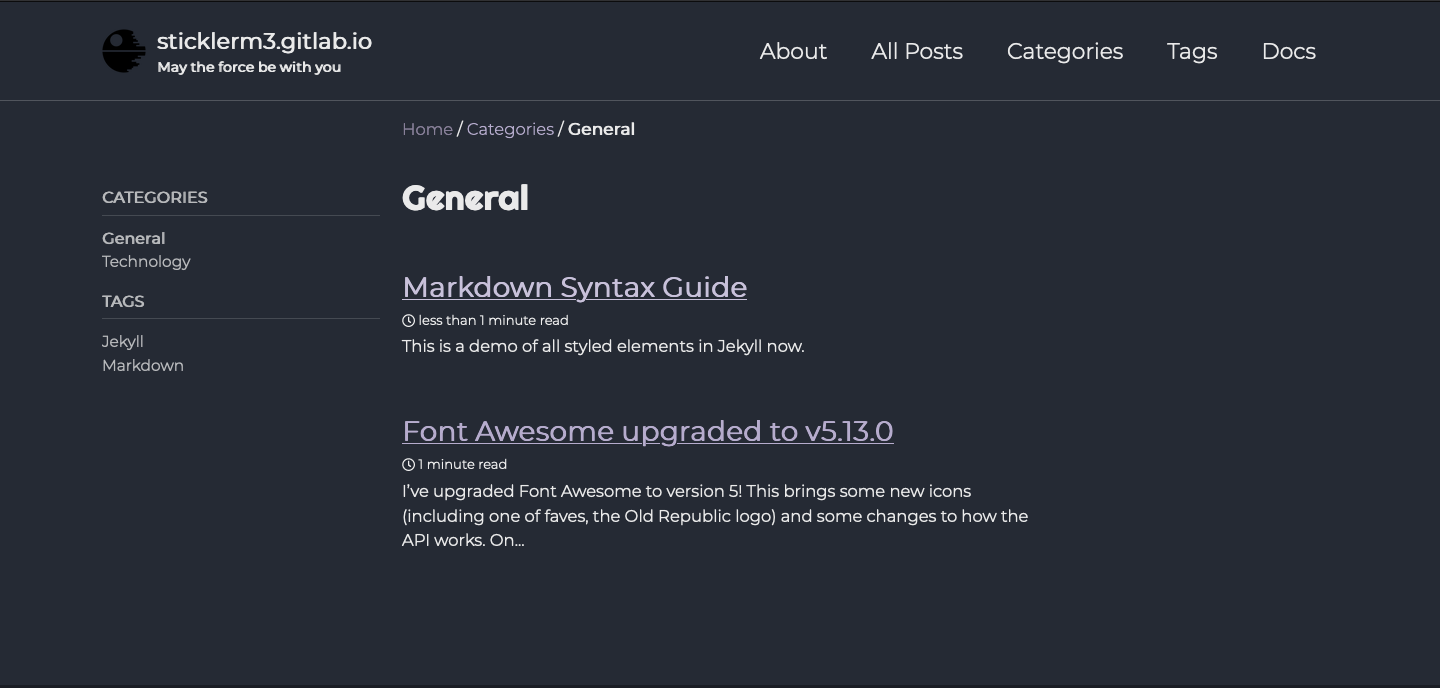In today’s experimentation, I did some work on the masthead and category archives. originally, I had created pages for each category and placed them in the _pages folder and enabled them in _data/navigation.yml in the main array. Since i’m not using GitHub pages however, I have the freedom of a bit more plugins. So I decided that rather than crowd the masthead with links to post categories, I would create a custom sidebar that would display on each post page and the archive pages.
Using archives
The basics of using jekyll-archives with minimal-mistakes can be found here. The gist is, Jekyll automatically creates an archive page for each category and tag used in their respective locations (/tags/tag-name, /categories/category-name, etc…). For now, I only have to categories I post in, General and Technology, but I plan on adding more as I go.
Once the plugin is installed, it’s time to configure Jekyll! I stuck with the instructions given by minimal-mistakes and my _config.yml looks like this:
# archive pages
category_archive:
type: jekyll-archives
path: /categories/
tag_archive:
type: jekyll-archives
path: /tags/
jekyll-archives:
enabled:
- categories
- tags
layouts:
category: archive-taxonomy
tag: archive-taxonomy
permalinks:
category: /categories/:name/
tag: /tags/:name/
Once configured, I started up the Jekyll server and navigated to one of the generated pages to verify that everything worked correctly. Everything checks out! Next step: clean up the masthead and create the sidebar!
In the _data/navigation.yml file I removed the links to general and technology and created a new custom sidebar called post.Create a title for the sidebar and then add the url’s for the corresponding categries. Since only two categories seemed a bit bare for now, I also added some lines for tags below that. As I go I’ll add frequently used ones so that they’re easier to access then browsing through the all posts page.
post:
- title: Categories
children:
- title: General
url: /categories/general/
- title: Technology
url: /categories/technology/
- title: Tags
children:
- title: Jekyll
url: /tags/jekyll/
- title: Markdown
url: /tags/markdown/
Next, add the custom sidebar to the desired pages. In my case that includes posts, category archives and tag archives. To save a future headache, adding the sidebar to your defaults: in _config.yml is the easiest. I already have a section for posts so all it took was adding sidebar: nav: "post", full configuration below.
defaults:
...
# _posts
- scope:
path: ""
type: posts
values:
sidebar:
nav: post
layout: single
author_profile: true
read_time: true
comments: false
share: false
related: true
Finally, it’s time to add the navbar to the archive pages. But wait! Those pages are generated during build-time and don’t exist in my repo! Luckily this can also be configured with defaults in your config file as well! Add a new scope: and leave the path: blank and in type: insert either category or tag. In the values: add the sidebar nav you created and you’re good to go! The configurations are below!
defaults:
...
- scope:
path: ""
type: category
values:
sidebar:
nav: post
- scope:
path: ""
type: tag
values:
sidebar:
nav: post


